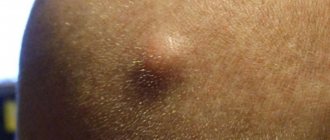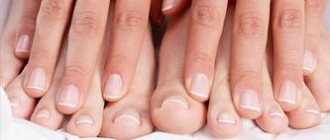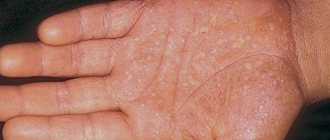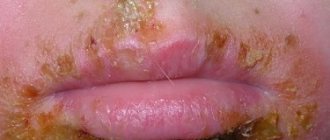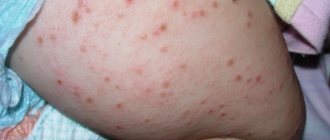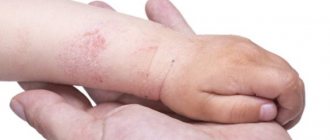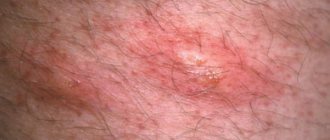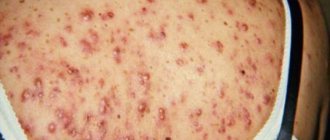Psoriasis in the groin area in men is a delicate problem. After all, the disease leads not only to physical, but also mental discomfort. Makes you feel embarrassed about the appearance of your skin (severe flaking on the pubic area), feel unattractive, and avoid people.
Have you had a full medical examination in the last 5 years?
Not really
But you shouldn’t isolate yourself. Although this disease has no cure, in most cases, with properly selected therapy, it is possible to achieve stable and long-term remission. But launching it leads to extremely unpleasant consequences.
Causes of psoriasis in the groin
It is believed that the main cause of the disease is improper functioning of the immune system. However, there is no clear evidence of this.
Therefore, there are a number of other factors that can provoke the disease:
- prolonged or severe stress;
- hormonal imbalances (including changes in the body during puberty, pregnancy and menopause);
- suffered serious illnesses (especially infectious);
- the presence of psoriasis in nearby areas of the body;
- diabetes;
- increased sweating in the groin area;
- insufficient intimate hygiene;
- inflamed wounds received during hair removal;
- endocrine problems.
In addition, the appearance of a rash can be triggered by factors such as regular mechanical irritation from clothing, constant humidity in the area, as well as insufficient access to air and sun (due to wearing synthetics).
Also, a psoriatic rash in the groin can be triggered by frequent drinking, smoking and a long course of strong drugs, especially those based on hormones.
Find out more
Causes of pathology
For what reason psoriatic plaques appear on the penis and perineum has not yet been determined. The opinion of scientists leans towards disruption of autoimmune processes in the human body. This is due to the fact that the protective cells of the immune system, under the influence of changes, begin to attack healthy skin cells, mistaking them for an enemy. The affected area grows, and the lesions spread throughout the body or are localized in certain areas, often merging with each other.
Scientists believe that other reasons for the development of the disease are theoretically possible:
- Metabolic disease.
- Hormonal imbalances.
- Allergy.
- Viral and bacterial infections.
- Genetic predisposition.
- Taking medications.
However, the influence of none of these factors has not been confirmed by research.
Symptoms of psoriasis in the groin
Key external manifestations of the disease:
- rashes that rise slightly above the skin;
- red, pinkish or purple undertone of formations;
- silvery coating on top of the rash (peeling);
- red color of the boundaries of formations;
- mild swelling of areas with rash;
- itching and burning (not always).
The diameter of individual formations varies from 3 to 20 mm. Usually, inguinal psoriasis is most severe in men; photographs of symptoms will help to verify this.
With increased sweating, peeling may not occur. Cracks may form in fold areas. Rashes also often affect the armpits and areas of skin under the breasts.
Often spots can appear on other parts of the body.
In children, photo
Childhood psoriasis has a more severe pathogenesis compared to adults. In children in the first years of life, rashes appear in the folds of the skin and are often mistakenly identified as diaper rash. In older children, the face and genitals are most often affected.
Children's psoriasis is most characterized by the guttate type of the disease. The rash in the form of droplets is located symmetrically and has a bright red or purple color. Peeling is also characteristic, but in a mild form and with prolonged moments of relief.
Psoriasis in the groin in men
Psoriasis in the groin in men has a number of features on which the entire treatment may depend.
The following areas are usually affected by the rash:
- penis head;
- pubis;
- testicles; buttocks and perineal area;
- area around the anus.
The disease can lead to the formation of bloody impurities in the sperm and impaired potency. If localized on the head of the penis, complications in the form of balanoposthitis (an inflammatory process in the inner region of the foreskin) are possible.
Photos of symptoms of psoriasis in the groin in men are available in large quantities on the Internet.
Diagnostic methods
Laboratory analysis will allow you to make an accurate diagnosis
Psoriasis in men on the penis can be confused with other dermatological diseases. Therefore, it needs to be diagnosed through a series of research activities.
To understand how to cure and how to combat genital psoriasis, you must first identify the disease itself. The following diagnostic methods can cope with this task:
- Visual inspection of the affected area of the patient;
- Anamnesis collection and complete study of the medical history;
- Determination of the chronology of the development of pathological symptoms;
- Conducting laboratory tests, during which a sample of urine and blood is examined;
- Carrying out analysis for the presence of fungal microflora.
When carrying out differential diagnosis, it is necessary to distinguish psoriasis from other similar diseases, for example, lupus erythematosus, pityriasis rosea, scabies and allergies.
Inguinal psoriasis in women
Psoriasis in the groin in women affects the following areas:
- labia (minor or major);
- buttocks and area around the anus;
- pubis and bikini line; vaginal mucosa.
In women, exacerbations of pathology are often observed during periods of hormonal changes. For example, during menstruation, during pregnancy, during the period after childbirth, and also during menopause. In addition, an attack of the rash can be triggered by poor nutrition, severely restrictive diets, severe stress and hypothermia.
If left untreated, psoriasis can cause vaginitis.
How to prevent exacerbation of the disease
If a man knows that he may get psoriasis, he should adhere to preventive measures. They consist of following simple rules:
- You need to stick to the right diet;
- It is necessary to promptly treat infectious diseases;
- It is necessary to quit bad habits;
- Injury to the genital organ should be avoided.
Treatment of penile psoriasis must be discussed with a competent doctor. The patient should not independently decide on the use of a particular drug in therapy without consulting a specialist. Otherwise, he may cause serious harm to his health.
Treatment of psoriasis in the groin
Rashes in the groin area usually respond poorly to treatment. Therefore, it is important to start treatment as early as possible.
As a rule, for psoriasis in the intimate area, treatment is characterized by an integrated approach. Medications are used in conjunction with physiotherapy and home recipes.
In general, the following methods can be distinguished:
- Local medications. In the form of ointments, gels, creams and solutions. May be hormone based. Designed to eliminate symptoms, soothe the skin and increase local immunity. All products are used exclusively externally and are prescribed by the attending physician.
- Systemic medications. Tablets or injections. Indicated for severe or advanced forms of the disease. Also prescribed in cases where local therapy does not give proper results. Usually, psoriasis is most severe in the groin area in men, photos demonstrate this well.
- Vitamins. Needed to maintain body strength and relieve symptoms.
- Physiotherapy. Procedures such as UV irradiation, PUVA therapy and laser exposure have proven themselves well. Physiotherapy can be used as part of spa treatment and complemented by measures such as mud baths or clay masks.
- Diet. It is exclusionary in nature. Potential provoking foods and unhealthy foods such as smoked meats and sweets are removed from the diet. The basis should be vegetables, healthy fats and proteins. It is better if the diet is compiled individually by a doctor.
If the disease is severe, the patient may be transferred to a hospital setting.
It is impossible to completely get rid of psoriasis. However, therapy helps prolong the period of remission and reduce symptoms during the next exacerbation.
Treatment of psoriasis in the groin with folk remedies
Home remedies can be a good addition to the main course of treatment. However, you cannot limit yourself to only them. In addition, any folk recipe can cause complications, and therefore requires prior consultation with a doctor.
Basic home remedies:
- Tar. Useful in the early stages of the disease. If there is no allergy to the component, it can be used regularly. Tar is applied to the skin in its pure form or used as part of ointments.
- Soda. May benefit from its ability to neutralize acidity. Usually added to baths and compresses. Helps relieve redness and swelling. Photos of psoriasis in the groin area clearly demonstrate these manifestations.
- Solid oil. A hypoallergenic product that is applied to the skin in pure form or as part of ointments and compresses.
- Propolis. A beekeeping product that has a soothing and healing effect.
- Herbs. Tinctures and decoctions are made from them, which are taken orally or added to baths. Compresses and lotions are also made from infusions. Regularity is important when using herbs. A single use will do nothing. The following plants are useful for psoriasis: elderberry and horsetail, linden flowers, lingonberries, violet flowers, elecampane, celandine, currant and nettle leaves, burdock roots. The standard course of using herbal formulations is 2-3 times a day for two weeks.
It is better to use traditional methods only in the first stages of the disease.
Treatment of psoriasis in the groin with medications
Among the medications for psoriasis between the legs, these types of drugs are usually prescribed:
- Moisturizing ointments and creams. Softens the skin and prevents it from cracking. Prevents peeling.
- Healing and antibacterial ointments. They weaken or completely eliminate the symptoms of the disease, and also prevent infection through microtraumas in the skin. Increase local immunity and tissue regeneration ability.
- Antihistamines. In the form of ointments, tablets or injections. They weaken the body's immune response to irritating factors and stop inflammatory processes.
- Sedatives. Calm the nervous system and slightly reduce symptoms. Sleeping pills and antidepressants can also be included in this category. The latter are prescribed extremely rarely.
- Corticosteroids. Hormone-based products. In the form of ointments, tablets or injections. They are prescribed in advanced cases and are tried to be avoided due to side effects.
- Vitamin complexes. Especially containing vitamins A, D and beneficial minerals.
Specific medications and dosages are prescribed by the attending physician. Self-medication can lead to aggravation of the situation.
How to treat
Treatment of the disease will depend on the exact diagnosis and the intensity of the complex of therapeutic measures. Such measures will include the use of external ointments, physiotherapy procedures, diet, taking strictly prescribed medications, and following general recommendations for psoriasis.
Before prescribing treatment, factors such as the person’s age, other existing diseases, the person’s professional activity and general level of health are taken into account. .
Treatment is carried out using both methods and techniques of traditional medicine and folk remedies.
Traditional medicine recommends:
- photochemotherapy;
- use of ointments (salicylic, naphthalan, tar);
- use of creams, aerosols and shampoos;
- drug treatment (cytostatics, cyclosporine, vitamins, enterosorbents, immunomodulatory agents, Suprastin, corticosteroid hormones);
- laser treatment of the disease.
To treat psoriatic disease, various drugs are usually used; a complex of therapy is needed to ensure the most pronounced effect. The selection of medications depends on many factors, the severity of the disease, concomitant pathologies, and the person’s age. Therefore, the course of treatment is often individualized depending on the characteristics of the patient.
Treatment is usually prescribed at home; psoriasis rarely requires a hospital stay; constant medical supervision is usually required only in severe cases of the disease.
The following drugs, ointments and some tablets are usually prescribed for this disease:
- Non-hormonal ointments. They help with mild forms of the disease, they can relieve itching and pain, soften the skin, and help remove peeling. Usually ointments based on salicylic acid, tar, and other similar products are used. Often, non-hormonal drugs are made on a plant basis; they rarely cause allergies.
- Hormonal ointments. They are usually prescribed for extensive damage, especially if it is accompanied by an inflammatory process and the release of exudate. Hydrocortisone-based ointments are usually used. You should not use hormonal ointments on your own; they can only be used after being prescribed by your doctor.
- Allergy medications. They are required if the development of psoriasis is affected by an allergic reaction to something. They try to use drugs of the latest generations, for example, Tavegil and others, but you can also use more familiar drugs like Suprastin.
- Various vitamin and mineral complexes. They may be prescribed additionally if the patient has vitamin deficiency. The lack of various important elements can negatively affect the course of the disease and must be eliminated.
Also during therapy it is necessary to follow a special diet. It is required so as not to provoke additional irritation. It is usually advised to avoid foods that can cause allergic reactions, spicy foods, various food additives, and dishes that are hard on the digestive tract. The diet will help bring psoriasis into remission faster.
Since the psoriasis shown in the photo is a chronic disease, you will have to fight it for the rest of your life. Glucocorticosteroid hormones and physiotherapy are actively used in the treatment process.
Prevention of psoriasis in the groin
Prevention measures can seriously delay relapses and alleviate the patient's condition immediately during an attack of the rash.
The following rules should be followed:
- Monitor your psycho-emotional state. One of the key factors. It is important to limit any stress and anxiety, and also try to always maintain a positive attitude. Negative emotions can provoke an exacerbation of the disease.
- Wear the right clothes. Underwear should not be tight or made of synthetic materials. The latter do not allow the skin to “breathe” and cause increased sweating.
- Control your diet. It is worth excluding or limiting spicy, salty and fried foods, as well as everything fatty, smoked and sweet. It doesn't hurt to remove potential allergens from your diet. These include citrus fruits, chocolate and coffee, nuts, all bee products, and eggs.
- Maintain a healthy lifestyle. It is important not only to give up cigarettes and alcohol, but also to follow the regime. Walking in the fresh air, moderate exercise and a daily routine will be beneficial.
- Rest. People with psoriasis need a moderate work schedule and adequate sleep. A visit to a sanatorium or a simple vacation at sea will also be beneficial. This will strengthen the immune system and improve the condition of the nervous system.
Compliance with the recommendations is the key to a comfortable life and the absence of frequent relapses.
Disease prevention
Main stages:
- Progressive. A man may notice redness or a rash on the foreskin or head of the penis. Psoriasis will immediately make itself felt with itching and burning. A person experiences discomfort, refuses sexual activity, is embarrassed by the appearance of his penis, and the itching that occurs in the folds of the skin leads to nervousness, which in turn intensifies the symptoms.
- Stationary. This stage is characterized by a stable condition: no new plaques appear, but the old ones still itch and itch. If treatment is not started at this stage of the disease, psoriasis of the scrotum or penis will quickly return to its original stage.
- Remission stage. With timely treatment, the disease that poisons a man’s life enters a regressive stage, at which the skin gradually clears of plaques and the itching stops. To prevent psoriasis of the glans penis from returning, it is important to complete the course of therapy. Otherwise, the disease will quickly return.
How often the period of exacerbation and remission will alternate, and how long each stage will last, depends on the man’s attitude towards his health. If you consult a doctor in a timely manner, follow all the doctor’s recommendations, have a healthy lifestyle and the absence of factors that provoke an exacerbation, the disease can “sleep” for quite a long time.
The causes of psoriasis in men and women are different. However, in order to prevent relapse, it is important to follow preventive measures:
- the likelihood of a disease occurring on the head of the penis will decrease if you strictly monitor hygiene and wear underwear made from natural materials;
- observe a rest and sleep schedule;
- Healthy food;
- treat infections regularly;
- get moderate physical activity;
- avoid stressful situations.
Many people are interested in the question of psoriasis and relationships with the other sex. As a rule, in the absence of concurrent diseases transmitted through intimate intimacy, contact is not prohibited. But you should protect yourself with contraceptives.
In general, the prognosis regarding the positive treatment of disease in the intimate area in an adult is positive. Provided you seek help in a timely manner.
An adult man may develop psoriasis on his penis. This is a non-infectious disease that brings the patient not only physical, but also psychological discomfort. Men aged 25 to 50 years are susceptible to pathology. It is extremely rare in children and adolescents. Treatment of psoriasis in the intimate area involves the use of a whole range of treatment procedures, thanks to which the patient’s condition improves.
We suggest you read: Is it possible to get tattoos with psoriasis and how to do it correctly
Genital psoriasis is considered a severe form of the pathology. But if symptoms are ignored, self-medication and delays in going to the doctor, the patient worsens his situation.
If the patient is not treated properly for a long time, the psoriatic papules may begin to coalesce, eventually forming a large affected area accompanied by severe pain.
First of all, the manifestations of this disease significantly worsen the quality of sexual life. Against the background of itching, libido decreases; the emotional state can also be affected by the very presence of rashes.
Sometimes the disease can even affect the skeletal system. In addition, the presence of pathology increases the risk of diabetes, stroke or coronary heart disease.
Despite the fact that genital psoriasis does not affect the reproductive function of both sexes, during its treatment hormonal medications may be prescribed, which can disrupt the normal course of pregnancy and cause miscarriage.
Prevention measures will help both avoid the appearance of genital psoriasis and delay relapse. Doctors recommend following these rules:
- Give up bad habits, namely smoking and alcohol.
- Maintain healthy sleep.
- Choose loose clothing made from natural materials to wear.
- Take walks in the fresh air more often.
- Adjust your diet. Limit fried, spicy, fatty foods, sweets and caffeinated drinks.
- Do not wear tight or chafing underwear.
- If you have a disease, avoid epilation of the bikini area; if you do not, reduce it to a minimum.
Genital psoriasis is a non-infectious disease that cannot be cured forever. It appears as pink or red papules, the affected areas are covered with scales and have a silvery color. As the plaques progress, they grow and can form quite large lesions, which will be accompanied by itching and pain. To make the treatment as easy and effective as possible, you should contact a dermatovenerologist at the first symptoms of the pathology.
Symptoms and specific manifestations of the disease
Signs of the disease can manifest themselves in completely different ways. For these reasons, it is very difficult to independently diagnose the disease without visiting a doctor. The patient can only make an assumption that he has psoriasis on the penis, but a specialist makes an accurate diagnosis after analysis and examination.
The main symptoms of this disease in men are factors such as:
Due to exacerbation of penile psoriasis (photo not shown for aesthetic reasons), it may happen that the redness spreads to the foreskin area. A patient with symptoms of penile psoriasis complains of swelling and pain. On the genitals, psoriasis can spread to the buttocks, scrotum and groin area.
Squamous lichen is one of the autoimmune diseases, and therefore the pathology is not transmitted through sexual or other means.
The most common types of psoriasis on the genitals are vulgar and inversive. Subcutaneous psoriasis vulgaris on the penis occurs sequentially.
